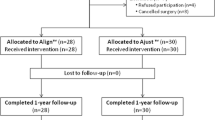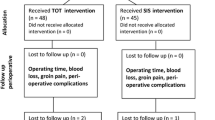Abstract
Introduction and hypothesis
The midurethral sling is the most commonly performed surgical procedure for stress urinary incontinence (SUI). We compared the efficacy of transobturator tape (TOT) and retropubic (RP) slings by evaluating objective and subjective cure rates at 12 months postsurgery and evaluate the impact on quality of life (QoL) and record intra- and postoperative complications.
Methods
This was a randomized, controlled, prospective, clinical trial with analysis of noninferiority. The hypothesis was that the TOT sling is not inferior to the RP sling. A total of 92 women with SUI were selected and randomized into two groups: TOT and RP slings.
Results
Eighty-one patients maintained follow-up 12 months postoperatively. In the per-protocol analysis, the objective cure rates were 100% for the RP sling and 93% for the TOT sling (p = 0.029). The subjective cure rates were 92% for the RP sling and 90% for the TOT sling (p = 0.02). Because none of the upper limits of the confidence interval (CI) were above the noninferiority margin, noninferiority of the TOT sling could be concluded. In contrast, the intention-to-treat analysis could not show that the TOT sling was not inferior to the RP sling, because the upper limit of the CI surpassed the noninferiority margin. Postoperative complications were similar for both groups, except for higher urinary retention rates in the RP group. Regarding QoL, there was a significant improvement.
Conclusions
The cure rates of the per-protocol analysis showed the noninferiority of the TOT relative to the RP sling. The RP sling group exhibited higher urinary retention. Quality of life improved significantly in both groups.

Similar content being viewed by others
References
Abrams P, Cardozo L, Fall M, Griffiths D, Rosier P, Ulmstein U, et al. The standardisation of terminology of lower urinary tract function: report from the standardisation sub-committee of the International Continence Society. Neurourol Urodyn. 2002;21:167–78.
Hunskaar A, Vinsnes S. The quality of life in women with urinary incontinence as measured by the sickness impact profile. J Am Geriatr Soc. 1991;39:378–82.
Hannestad YS, Rortveit G, Sandvik H, Hunskaar S. A community-based epidemiological survey of female urinary incontinence: the Norwegian EPINCONT study. Epidemiology of Incontinence in the County of NordTrondelag. J Clin Epidemiol. 2000;53:1150–7.
Oliphant SS, Wang L, Bunker CH, Lowder JL. Trends in stress urinary incontinence inpatient procedures in the United States, 1979-2004. Am J Obstet Gynecol. 2009;200(521):e1–6.
Erekson EA, Lopes VV, Raker CA, Sung VW. Ambulatory procedures for female pelvic floor disorders in the United States. Am J Obstet Gynecol. 2010;203(497):e1–5.
Anger JT, Weinberg AE, Smith AL, Albo ME, Kim JH, Rodriguez LV, et al. Trends in surgical management of stress urinary incontinence among female Medicare beneficiaries. Urology. 2009;74:283–7.
Ulmsten U, Henriksson L, Johnson P, Varhos G. An ambulatory surgical procedure under local anesthesia for treatment of female urinary incontinence. Int Urogynecol J Pelvic Floor Dysfunct. 1996;7:81–6.
Celebi I, Gungorduk K, Ark C, Akyol A. Results of the tensionfree vaginal tape procedure for treatment of female stress urinary incontinence: a 5-year follow-up study. Arch Gynecol Obstet. 2009;279:463–7.
Olsson I, Abrahamsson AK, Kroon UB. Long-term efficacy of the tension-free vaginal tape procedure for the treatment of urinary incontinence. A retrospective follow-up 11.5 years postoperatively. Int Urogynecol J. 2010;21:679–83.
Karram MM, Segal JL, Vassallo BJ, Kleeman SD. Complications and untoward effects of the tension-free vaginal tape procedure. Obstet Gynecol. 2003;101:929–32.
Sander P, Sorensen F, Lose G. Does the Tension-Free Vaginal Tape procedure (TVT) affect the voiding function over time? Pressure-flow studies 1 year and 3½ years after TVT. Neurourol Urodyn. 2007;26:995–7.
De Leval J. Novel surgical technique for the treatment of stress urinary incontinence: transobturator vaginal tape inside-out. Eur Urol. 2003;44:724–30.
Hazewinkel MH, Hinoul P, Roovers JP. Persistent groin pain following a trans-obturator sling procedure for stress urinary incontinence: a diagnostic and therapeutic challenge. Int Urogynecol J Pelvic Floor Dysfunct. 2009;20:363–5.
Lier D, Ross S, Tang S, Robert M, Jacobs P. Trans-obturator tape compared with tension-free vaginal tape in the surgical treatment of stress urinary incontinence: a cost utility analysis. BJOG. 2011;118:550–6.
George S, Begum R, Thomas-Philip A, Thirumalakumar L, Sorinola O. Two-year comparison of tension-free vaginal tape and transobturator tape for female urinary stress incontinence. Obstet Gynecol. 2010;30:281–4.
Kenton K, Stoddard AM, Zyczynski H, et al. 5-Year longitudinal follow-up after retropubic and transobturator midurethral slings. J Urol. 2015;193(1):203–10.
Chawla A. Transobturator tapes are preferable over transvaginal tapes for the management of female stress urinary incontinence: against. Indian J Urol. 2009;25:554–7.
Schafer W, Abrams P, Liao L, Mattiasson A, Pesce F, Spangberg A, et al. Good urodynamic practices: uroflowmetry, filling cystometry, and pressure-flow studies. Neurourol Urodyn. 2002;21:261–74.
Wu WY, Sheu BC, Lin HH. Comparison of 20-minute pad test versus 1-hour pad test in women with stress urinary incontinence. Urology. 2006;68(4):764–8.
Souza CC, Rodrigues AM, Ferreira CE, et al. Portuguese validation of the Urinary Incontinence-Specific Quality-of-Life Instrument: IQoL. Int Urogynecol J Pelvic Floor Dysfunct. 2009;20(10):1183–9.
Uebersax JS, Wyman JF, Shumaker SA, McClish DK, Fantl JA. Short forms to assess life quality and symptom distress for urinary incontinence in women: the Incontinence Impact Questionnaire and the Urogenital Distress Inventory. Continence Program for Women Research Group. Neurourol Urodyn. 1995;14(2):131–9.
Tommaselli GA, Di Carlo C, Formisano C, Fabozzi A, Nappi C. Medium-term and long-term outcomes following placement of midurethral slings for stress urinary incontinence: a systematic review and metaanalysis. Int Urogynecol J. 2015;26:1253–68.
Richter HE, Albo ME, Zyczynski HM, Kenton K, Norton PA, Sirls LT, et al. Retropubic versus transobturator midurethral slings for stress incontinence. N Engl J Med. 2010;362(22):2066–76.
Ford AA, Ogah JA. Retropubic or transobturator mid-urethral slings for intrinsic sphincter deficiency-related stress urinary incontinence in women: a systematic review and meta-analysis. Int Urogynecol J. 2016;27(1):19–28.
Novara G, Artibani W, Barber MD, Chapple CR, Costantini E, Ficarra V, et al. Updated systematic review and meta-analysis of the comparative data on colposuspensions, pubovaginal slings, and midurethral tapes in the surgical treatment of female stress urinary incontinence. Eur Urol. 2010;58:218–38.
Tanuri ALS. Feldner JrPS, Jarmy-Di Bella ZIK, Castro RA, Sartori MGF, Girão MJBC. "Sling" retropúbico e transobturatório no tratamento da incontinência urinária de esforço. Rev Assoc Med Bras. 2010;56(3):348–54.
Zhang Z, Zhu L, Xu T, Lang J. Retropubic tension-free vaginal tape and inside-out transobturator tape: a long-term randomized trial. Int Urogynecol J. 2016;27(1):103–11.
Ya-fei Z, Guo-lan G, Lin-sheng H, Jun T, Qin-ke C. Inside out transobturator vaginal tape versus tension-free vaginal tape for primary female stress urinary incontinence: meta-analysis of randomized controlled trials. Chin Med J. 2012;125(7):1316–21.
Latthe PM, Foon R, Toozs-Hobson P. Transobturator and retropubic tape procedures in stress urinary incontinence: a systematic review and meta-analysis of effectiveness and complications. BJOG. 2007;114(5):522–31.
Tan PF, Yang LL, Ou RB, Tang P, Yang WJ, Huang JB, et al. Effectiveness and complication rates of tension-free vaginal tape, transobturator tape, and tension-free vaginal tape-obturator in the treatment of female stress urinary incontinence in a medium- to long-term follow up: meta-analysis of randomized controlled trials. Saudi Med J. 2014;35(1):20–32.
Sun X, Yang Q, Sun F, Shi Q. Comparison between the retropubic and transobturator approaches in the treatment of female stress urinary incontinence: a systematic review and meta-analysis of effectiveness and complications. Int Braz J Urol. 2015;41:220–9.
Albo ME, Litman HJ, Richter HE, Lemack GE, Sirls LT, Chai TC, et al. Treatment success of retropubic and transobturator midurethral slings at 24-months. J Urol. 2012;188(6):2281–7.
Brubaker L, Norton PA, Albo ME, Chai TC, Dandreo KJ, Lloyd KL, et al. Adverse events over two years after retropubic or transobturator midurethral sling surgery: findings from the Trial of Midurethral Sling (TOMUS) Study. Am J Obstet Gynecol. 2011;205(5):498.
Petri E, Ashok K. Comparison of late complications of retropubic and transobturator slings in stress urinary incontinence. Int Urogynecol J. 2012;23:321–5.
Betschart C, Scheiner D, Hess E, Seifert B, Fink D, Perucchin D. Patient satisfaction after retropubic and transobturator slings: first assessment using the Incontinence Outcome Questionnaire (IOQ). Int Urogynecol J. 2011;22:805–12.
Iancu G, Peltecu G. Predicting the outcome of mid-urethral tape surgery for stress urinary incontinence using preoperative urodynamics - a systematic review. Chirurgia (Bucur). 2014;109(3):359–68.
Author information
Authors and Affiliations
Corresponding author
Ethics declarations
Conflicts of Interest
None.
Rights and permissions
About this article
Cite this article
Palos, C.C., Maturana, A.P., Ghersel, F.R. et al. Prospective and randomized clinical trial comparing transobturator versus retropubic sling in terms of efficacy and safety. Int Urogynecol J 29, 29–35 (2018). https://doi.org/10.1007/s00192-017-3495-0
Received:
Accepted:
Published:
Issue Date:
DOI: https://doi.org/10.1007/s00192-017-3495-0




